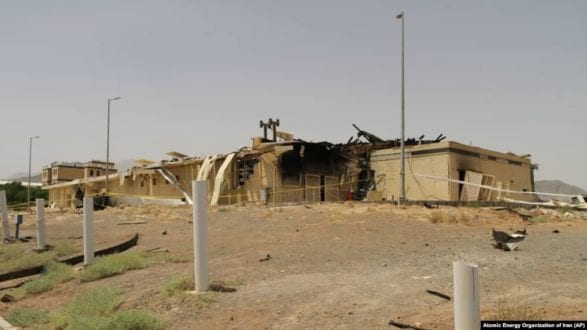Radiofarda – A mysterious explosion and fire in one of Iran’s nuclear facilities has opened the flood gates to speculations and analysis as to whether it was an accident, sabotage or foreign attack.
A spokesman for the Atomic Energy Organization of Iran (AEOI) announced on Thursday, July 2, that an “accident” had occurred at the Natanz nuclear enrichment facility in Isfahan province at around 2 am local time.
The state-run Iran Students News Agency (ISNA) cited Behrouz Kamalvandi as saying that the “accident” took place in one of the sheds in the “open area” of Natanz facilities.
“One of the sheds under construction in the open area of Natanz Nuclear Facility was damaged this morning, and investigation on the case is underway,” Kamalvandi maintained.
The incident had no casualties and has not incurred any damage to the facility’s current activities, Kamalvandi insisted and repeated his claim throughout the day.
From photos and images released by Iran, the visible damage does not look like an airstrike – a possibility that many were quick to consider, as Israel has threatened many times not to allow Iran to build a nuclear bomb.
However, Kamalvandi stopped short of referring to the cause of the “accident.” He insisted that the incident did not cause the kind of damage to lead to any radioactive contamination.
Hours later, news began to circulate that many current and former BBC Persian journalists had received an email by an unknown group claiming “an operation” against the Natanz facility hours before the government announced it, lending credibility to the authors of the statement that at least they had advance information.
Kamalvandi also revealed that the head of AEOI, Ali Akbar Salehi, has rushed to Natanz to assist the investigation team.
At the same time, Natanz Governor Ramazan Ali Ferdowsi also told Tasnim News Agency that “firefighters and rescue workers were dispatched to the scene as soon as the fire broke out.” The Governor also stopped short of providing any details.
Meanwhile, an expert on Iran’s missile program at the Middlebury Institute in California, Fabian Hinz, tweeted, “The initial image released by the Atomic Energy Organization of Iran shows that the site of the ‘accident’ was the Iranian centrifuge assembly center.”
“It would delay the advancement of the centrifuge technology quite a bit at Natanz,” Hinz said. “Once you have done your research and development, you can’t undo that research and development. Targeting them would be very useful” for Iran’s adversaries, AP quoted Hinz as saying.
The site of the fire and explosion corresponds to a newly inaugurated centrifuge production facility, reiterated Fabian Hinz, adding that his assessment was based on the geographical location of the photo published by AEOI and the images taken by Google satellites.
Iranian nuclear officials did not respond to a request for comment about the analysts’ remarks. However, any damage to the facility would be a major setback, said Hinz, who called the fire “very, very suspicious,” AP reported.
A few hours before the news of the Natanz incident broke out on Thursday morning, a mysterious group called “Homeland Panthers” claimed responsibility for the incident in an email sent to a seemingly older list of BBC Persian journalists. Some who stopped working at the BBC years ago also received the email.
The “Homeland Panthers” claimed in their email that they are “active” and “present among the Islamic Republic’s intelligence organs.”
In his tweets on Thursday, Jiyar Gol, a BBC Persian journalist, said he had been among the recipients of the email, which included some details about the attack. “The email claimed that there had been other attacks that the government had covered up,” he wrote and added that the group said this time the government would not be able to cover up the attack because “it was not [at an] underground facility”.
Whether the people calling themselves Homeland Panthers are domestic opponents, internal regime dissidents or a foreign group who have infiltrated Iran is impossible to say at this point. But whoever sent the email had timely information about the incident.
Natanz uranium enrichment facility covers an area of 100,000 square meters (ten hectares) and built eight meters (about 25 feet) underground. This site is the main uranium enrichment center in Iran.
Iran announced last April that a new generation of centrifuges would soon be unveiled at Natanz’s enrichment facility.
The Natanz facility came to the fore in November last year when Iran fired an inspector from the International Atomic Energy Agency and then accused her of plotting “industrial sabotage” at the Natanz nuclear facility.
At the time, Iran said that the woman triggered an alarm at the gate to the Natanz uranium enrichment plant, raising fears that she was carrying “suspicious material.”
The IAEA immediately dismissed the claim and said the inspector was also temporarily prevented from leaving Iran.
Natanz’s “accident” occurs less than a week after the sighting of a dazzling light, and what looked like an explosion in eastern Tehran became the headline across Iran.
The explosion occurred at the Khojir area, near the village of Parchin, the site of an Iranian military complex with the same name, located about thirty kilometers (nineteen miles) southeast of the capital city, Tehran.
Citing officials, the Islamic Republic of Iran Broadcasting (IRIB) news agency attributed the blast to an explosion at a natural gas storage, insisting that it occurred at a non-residential area, and left no casualties.
While the Islamic Republic authorities have sought to downplay the fire, the New York Times reported, “A Middle Eastern intelligence official—said the blast was caused by an explosive device planted inside the facility. The explosion, he said, destroyed much of the aboveground parts of the facility.”
 Shabtabnews In this dark night, I have lost my way – Arise from a corner, oh you the star of guidance.
Shabtabnews In this dark night, I have lost my way – Arise from a corner, oh you the star of guidance.



